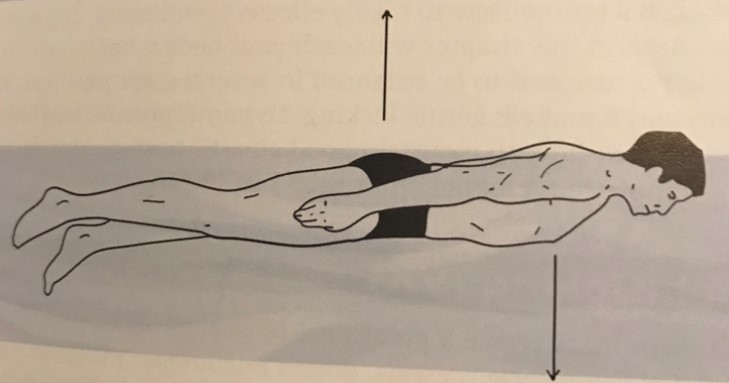Front Balance (FB) is a Static Posture and Balance Drill
Front balance (FB) swim drill is done using good tight-line posture. A schlumpy posture will slow you down, feel less supported, will have trouble regaining balance after breaths and spends more more energy. Reorganizing your head, torso and hips back into good, tall, aquatic posture will quickly solve those issues.
Front balance is achieved by pushing off the wall on your belly with both arms at your sides and begin kicking easily. Check to be sure your posture is organized tall -- remember the tight-line focus point. The crown of your head should be in line with your spine, nose pointed toward the bottom of the pool. Lightly press your chest (your buoy) toward the bottom. This will raise your hips toward the surface. Adjust the amount of buoy pressure so that the cheeks of your butt just break the surface. Don't make the mistake of pushing your face, instead of your buoy, toward the bottom -- you may need to consciously tuck your chin a bit and draw your face away from the bottom to maintain your tall posture.

Front Balanced Drill Breathing
To Breath in the front balance position, lift your head straight up in front and get a breath of air, then put your head down so that the crown is in line with your spine. Press your chest buoy again and make sure to re-flatten your lower back and lengthen your neck, making yourself as tall as possible. Do not use your hands to get back into the balanced position. You are teaching yourself what it feels like to be unbalanced and how if feels to be balanced and how to stay balanced. Each time you lift your head, your hips and legs sink rapidly toward the bottom. As soon as you return to good posture and press your chest buoy, you regain balance.
Performance Feedback
1. When your posture is correct and you are in balance, the back quarter of your head and most of your backside (including your shoulder blades and the cheeks of your butt) will be exposed to the air, and your heels will just break the surface as you kick.
2. In your nose-down position, you should see the hairballs and band-aids directly under your face, not the one's you will be swimming over as you cruise over them.
3. If water enters the training snorkel you may use to help you assume the balanced aquatic position, it usually indicates that you have buried your head (which means you have pushed your face toward the bottom of the pool instead of keeping your head in tight-line posture) or that you have buried your whole front end by putting too much pressure on your buoy.
Aquatic Balance
Aquatic balance is dependent on aquatic posture. You need to have your entire body parallel to the surface of the water. Many go about it the wrong way by trying to use a strong kick to lift their hips and legs to the surface. Kicking uses a tremendous amount of energy. Great swimmers use a different approach that requires a lot less energy, and it starts with holding a tight line of good aquatic posture but adds keeping your head in line and pressing the your chest buoy (lungs).
Your head, weighing about 10 pounds, and its position have a great influence on the balance of your body in the water. The crown of your head needs to be in line with your spine, and your nose needs to be pointed straight at the bottom of the pool when not breathing. Lifting or tilting your head off this line puts a lot of downward force on your hips, causing them to sink.
Pressing your Chest
Pressing your lungs full of air will help keep you balanced. Your lungs are a buoy that tends to float the upper body. By contrast, your center of mass, which is located near your navel, tends to sink your hips and legs.

If you press one end of the kickboard toward the bottom, the other end rises. Similarly, if you are holding a tight line, then leaning on your buoy to press it toward the bottom raises your hips. The greater the force you lean on your buoy with, the greater the buoyant force of the water to hold your spinal tight line on the surface. As you press your chest buoy, you should feel your entire body tilting slightly downhill, fully supported by the water.
back to the top of front balance








